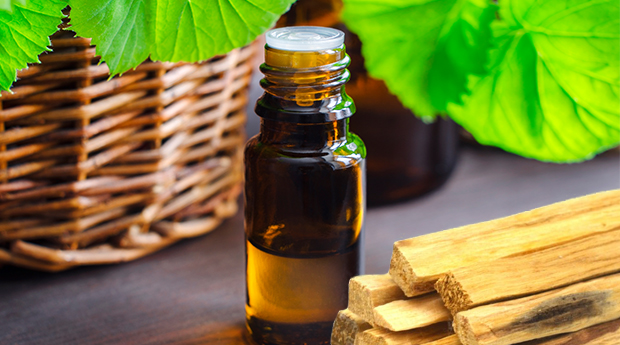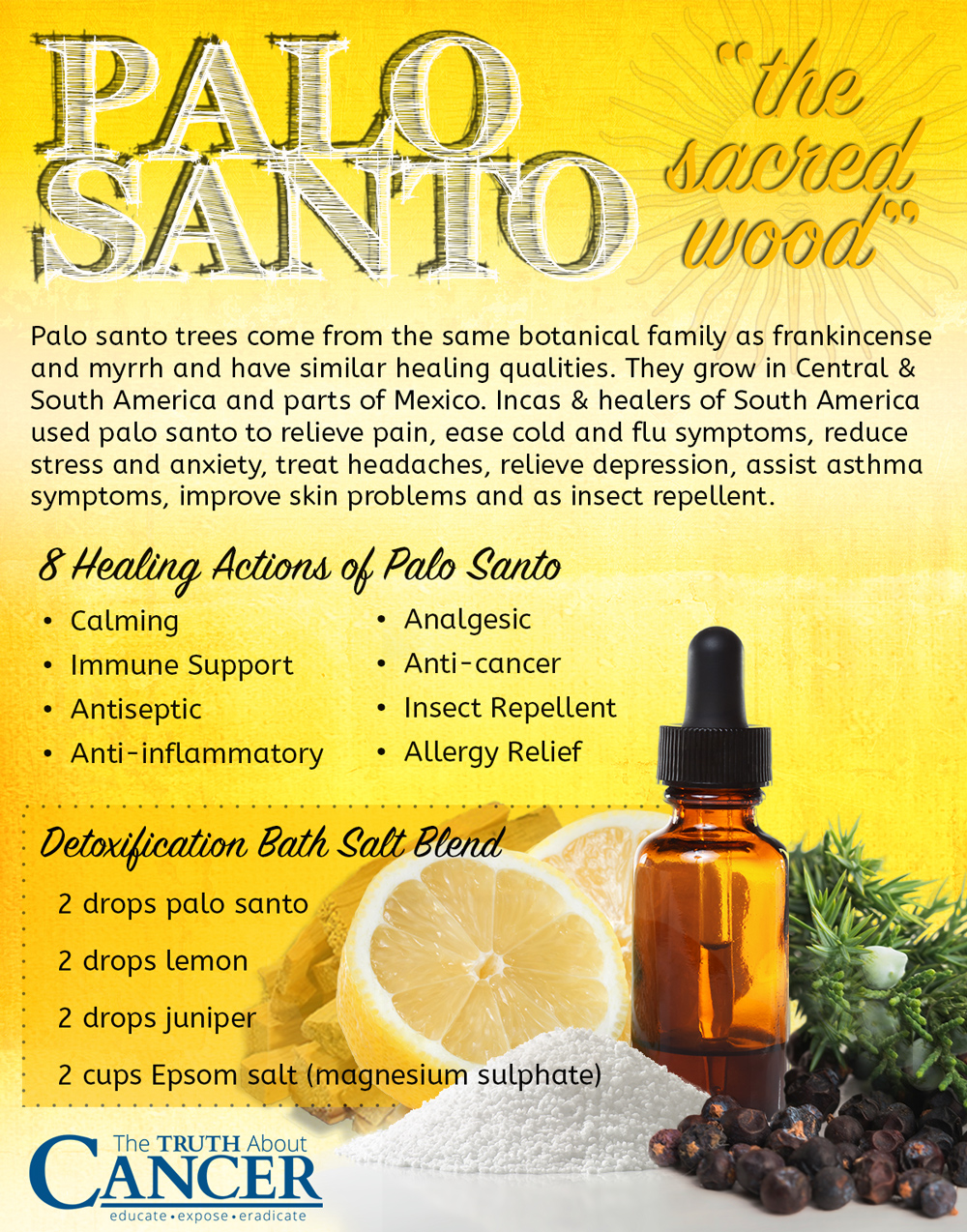Frankincense with a boost! That’s one way of describing palo santo (Spanish for holy or sacred wood) essential oil. If you have never experienced it, you owe it to yourself to give palo santo a try. With its heady aroma, it is one of the most beautifully scented wood-derived essential oils.
Palo santo trees come from the same botanical family as frankincense and myrrh and they have similar healing qualities. Some have described the fragrance of palo santo to be woodsy, with citrus notes. But for those of us who love it and know it well, palo santo is more like frankincense but deeper, richer, more resiny and lung-opening. Palo santo doesn’t just smell amazing though, it has some wonderful healing qualities. This article will share that information, some interesting research on palo santo, as well as some great ways to use it.
Palo santo (Bursera graveolens) trees grow in Central and South America and parts of Mexico. The trees grow to be about 80 years old and when the tree dies, the wood is allowed to lie for a couple of years. Only then is the oil extracted from the bark using steam distillation.
In Ecuador and Peru, palo santo trees are protected − it is against the law to cut down palo santo trees or take any branches away. It’s good to know that the trees are not cut down for the essential oil but allowed to live normally, grow, and die in their own time before the oil is extracted. That makes palo santo a 100% sustainable oil!
Historical Use of Palo Santo
The Incas and healers of South America traditionally used palo santo to dispel negative energy, and for cleansing and purifying rituals. It was used for relieving pain, easing cold and flu symptoms, reducing stress and anxiety, treating headaches, relieving depression, assisting asthma symptoms and improving skin problems. It was even used for repelling insects. Modern science is discovering that palo santo is indeed good for many of these traditional uses.
Phytochemical Content of Palo Santo Oil
Surprisingly, the major phytochemical (natural, plant-based chemical) content of palo santo is limonene. When initially studied, this was somewhat unexpected because limonene is found in abundance in the rinds and flesh of citrus fruit. Limonene is one of the most researched phytochemicals in existence. There are well over 200 published studies on it, most of which attest to its anti-cancer properties. Alpha-terpineol is another phytochemical found in palo santo (about 11%) and also the subject of much recent research.
A 2004 study found five interesting sesquiterpenoids in palo santo oil, some of them quite unique. Sesquiterpenes are important phytochemicals because their small molecular size allows them to cross the blood-brain-barrier. This enables them to positively influence the brain and central nervous system. They assist with brain function and stimulate the hypothalamus (the master gland) and other regions of the brain such as the pineal and pituitary glands. Thus, sesquiterpenes can act to calm and balance the emotions, the brain, and the endocrine (hormonal) system.
8 Healing Actions of Palo Santo
- Calming. Palo santo is excellent for easing heightened feelings of anxiety and stress. A natural nerve calmer, it is centering, grounding, and helps to switch on the body’s relaxation response, so it’s excellent to take prior to bed. Tip for use: Put a couple drops of oil into your hands, rub them together and make a tent over your nose and mouth (avoiding the eyes), and just breathe in deeply for a couple of minutes to enjoy the calming effects of palo santo.
- Immune Support. Palo santo is perfect for boosting immunity when you’re hit with colds, flu, lung infections, or just generally feeling run down. It’s a natural anti-inflammatory, and it fights infections and viruses so you can feel better much more quickly. Tip for use: Palo santo is on the United States Food & Drug Administration’s list of GRAS essential oils (generally regarded as safe) to consume. However, please ensure that the oil you are using is of a high quality, pure, medicinal grade oil. Make a tea with it – just add a drop or two to a cup of very hot (but not boiled) filtered water and sip it. If there is chest congestion, massage a drop or two of oil into the chest and breathe deeply.
- Antiseptic. Due to its infection fighting ability, palo santo is great for cuts, abrasions, insect bites, and other minor wounds. Tip for use: Rub a drop or two of palo santo on the affected area, being careful to dilute with an organic carrier oil like almond or coconut if you have sensitive skin. Keep out of open wounds, but you can carefully apply the oil within a respectable distance of an open wound and it will help protect it and ease any pain and/or inflammation.
- Anti-inflammatory. Due in part to its high limonene content, palo santo has excellent anti-inflammatory effects. Preclinical studies looking into mammary carcinogenesis (the initiation of cancer formation in the breast) and other inflammation-related disorders found that supplementing with limonene helped to reduce inflammation, decrease cytokines, and protect cells. Tip for use: Add a drop or two of palo santo oil to one teaspoon of organic carrier oil and massage it in topically.
- Analgesic. Palo santo is a powerful pain reliever. It helps to relieve pain in muscles, joints, sore and torn ligaments and tendons as well as relieves headache and migraine pain. Tip for use: Palo santo can be used neat directly on area of concern, however, if you have sensitive skin you may want to dilute with an organic carrier oil. For headache pain, gently massage the oil (neat or diluted) into the sides of the neck over the large arteries. Also massage into the back of the neck just under the base of the skull in the hairline.
- Anti-cancer. Due to palo santo’s anti-inflammatory activity and the high limonene content, it may have potent anti-cancer activity. Covered extensively in our article on citrus essential oils, limonene is a much-studied phytochemical, not only in test tubes but also in animal and human trials. It is considered to be a powerful cancer fighter.
- Cuban research reported in 2012 in Natural Product Communications found that palo santo essential oil inhibited the growth of MCF-7 breast cancer cells. MCF-7 cells are are estrogen-receptor positive and progesterone-receptor positive, infiltrating ductal carcinoma cells, one of the most common types of breast cancer.
- An older Japanese study published in 2005 in Chemical & Pharmaceutical Bulletin (Tokyo) discovered new phytochemicals in palo santo which are capable of reducing cancerous cell mutations. The researchers made particular mention of its “remarkable inhibitory activity against human HT1080 fibrosarcoma cells.” They also discovered a new lignan known as burseranin in palo santo. Lignans are important fiber-associated compounds found widely in edible plants (think flaxseed), and also linked to a reduced risk for breast and other cancers.
- Tip for use: While essential oils should not be considered as a sole treatment against cancer, when used together with other treatments (both conventional and natural), they can be a vital part of the anti-cancer arsenal. Use palo santo topically, and/or take it internally (as described in paragraph 2 above). Palo santo can also be diffused into the air of a room where you intend to sit for an hour or so, using a cool mist, ultrasonic diffuser.
- Insect Repellent – Palo santo is an excellent insect repellent, it can be used to protect against a variety of mosquitos and other flying insects. Ants and spiders don’t like it either! Tip for use: Into a glass spray bottle, fill bottle with distilled water, then add 10-20 drops of palo santo. Shake the bottle prior to use to combine the essential oil and distilled water, then spray onto exposed skin.
- Allergy Relief – A natural antihistamine, palo santo helps reduce allergy symptoms by reducing inflammation and easing off the body’s release of histamines in response to allergens. Tip for use: Diffuse as in paragraph 6 above or breathe in deeply as described in paragraph 1 above.
Here’s a special bonus for you, a recipe you can easily make for a wonderful and detoxifying salt bath. This helps to reduce muscle pain, eases low moods and banishes negative energy.
[amd-zlrecipe-recipe:27]
Tips for Using Essential Oils
If you intend to use palo santo essential oil for therapeutic purposes, be aware that essential oil quality varies widely. Discover whether the supplier of the brand of essential oil you intend to use utilizes organic growing methods. Be sure they know how to properly distill the oils. Buy your oils from a trusted source because if they are not properly grown or distilled, they can be adulterated with toxic chemicals which, rather than healing, can be harmful.
Do not apply essential oils inside ears, anywhere near the eyes, or other sensitive areas of the body.
Dilute essential oils prior to application using an organic carrier oil like jojoba, almond, coconut, hemp or argan.
Be cautious when using essential oils with children and in pregnancy. Always heavily dilute essential oils for children and it’s best not to use them with children under age 5. Some oils need to be avoided during pregnancy. If you are unsure, work with an experienced aromatherapist.
Over 2 million people have joined The Truth About Cancer’s fight to eradicate cancer once and for all. If you want to find real solutions… plus hear the truth about all the misinformation out there about cancer, click here to join the movement (it’s free).
Article Summary
Palo santo trees come from the same botanical family as frankincense and myrrh and they have similar healing qualities.
8 healing actions of palo santo:
- Calming
- Immune Support
- Antiseptic
- Anti-inflammatory
- Analgesic
- Anti-cancer
- Insect Repellant
- Allergy Relief




















Where is best place to purchase Pali Santa Oil? Do you have a brand your recommend?
I just purchased Palo Santo organic essential oil from New Directions. It is wonderful
I recommend the oil from the fruit of palo santo trees of the Aroma Santo Company, it is an Ecuadorian oil, very good, the elaboration of this oil is a sustainable project, since they do not harm the tree, they only use the fruit of the palo santo tree which they harvest in the winter season.
Didn’t know of all the benefits of palo Santo. Thanks for the information. Very informative.
How do I purchase the Frankincense oil?
Just ordered palo santo essential oil, after reading this article.
I am amassing a supply of 20 “basic” essential oils for topical and internal use, particularly for pain management and antimicrobial benefits.
The feeling of empowerment that comes from knowing how to use nature’s medicine cabinet is indescribable – and humbling.
Thank you for this article, and all of the information you so generously share.
God bless.
Where did you buy the oil?
Where did you buy your Palo Santo oil please?
Where can I buy Palo Santo oil?
Hi Georgina,
We don’t have a specific brand or location that we suggest getting Palo Santo oil from.
Try Young Living or Doterra
Thank you so much for this very informative article! I love and utilize Palo Santo essential oil myself on a regular basis, I really like and trust One Love Holistics, as quality is very important to them! Hope this was of help to you all, blessings!
Have you tried the oil from the fruit of the palo santo trees? I am an athlete and I usually use it for muscle pain, post training and it really works wonders. I recommend it a lot. Besides, the elaboration of this oil is a sustainable project, since they do not harm the tree, they only use the fruit of the palo santo tree which they harvest in the winter season.
I use it for bladder infections. One capsule (made with 1 to 2 drops of palo santo and coconut oil) stops it in its tracks. This has saved me from going to emerg a few times.